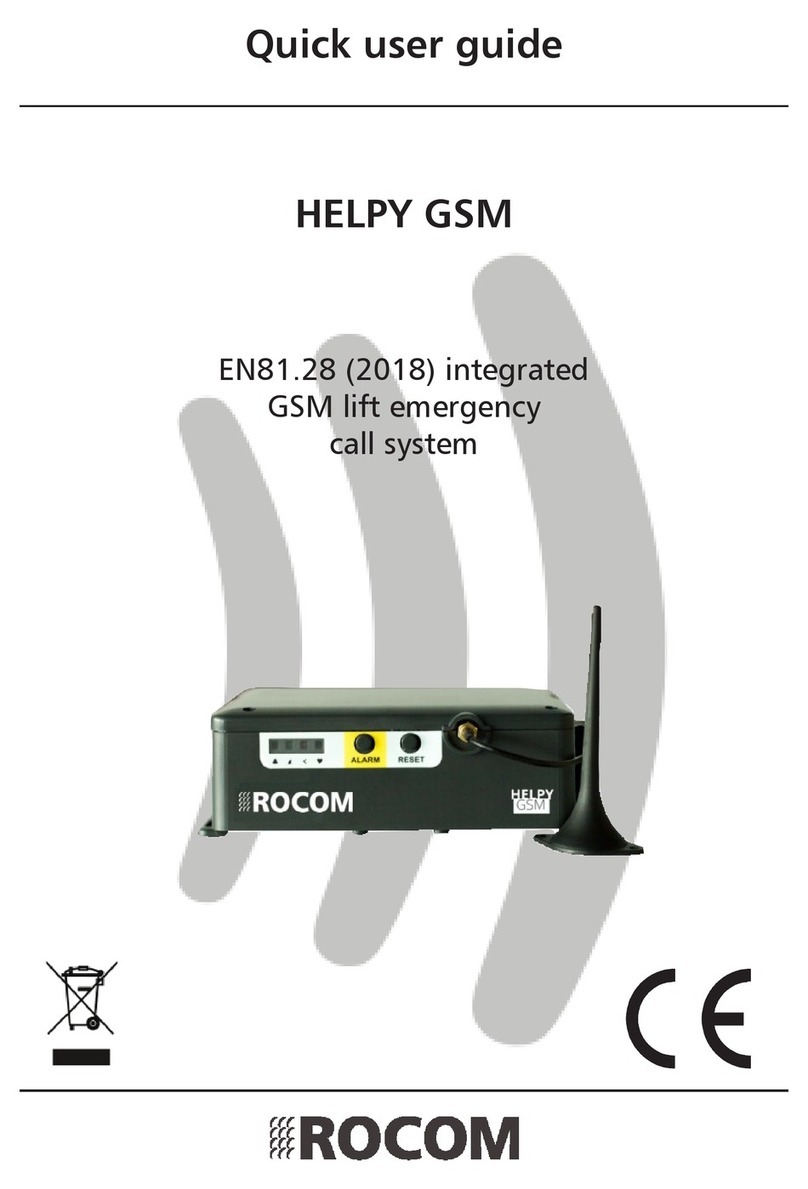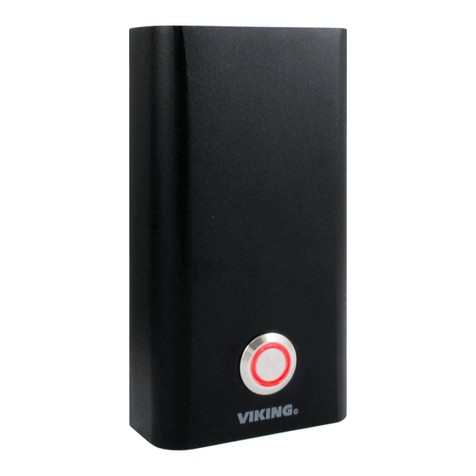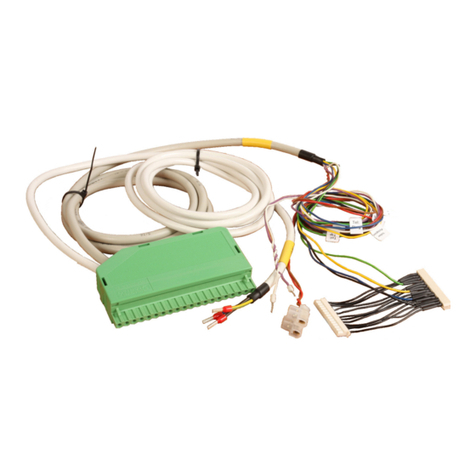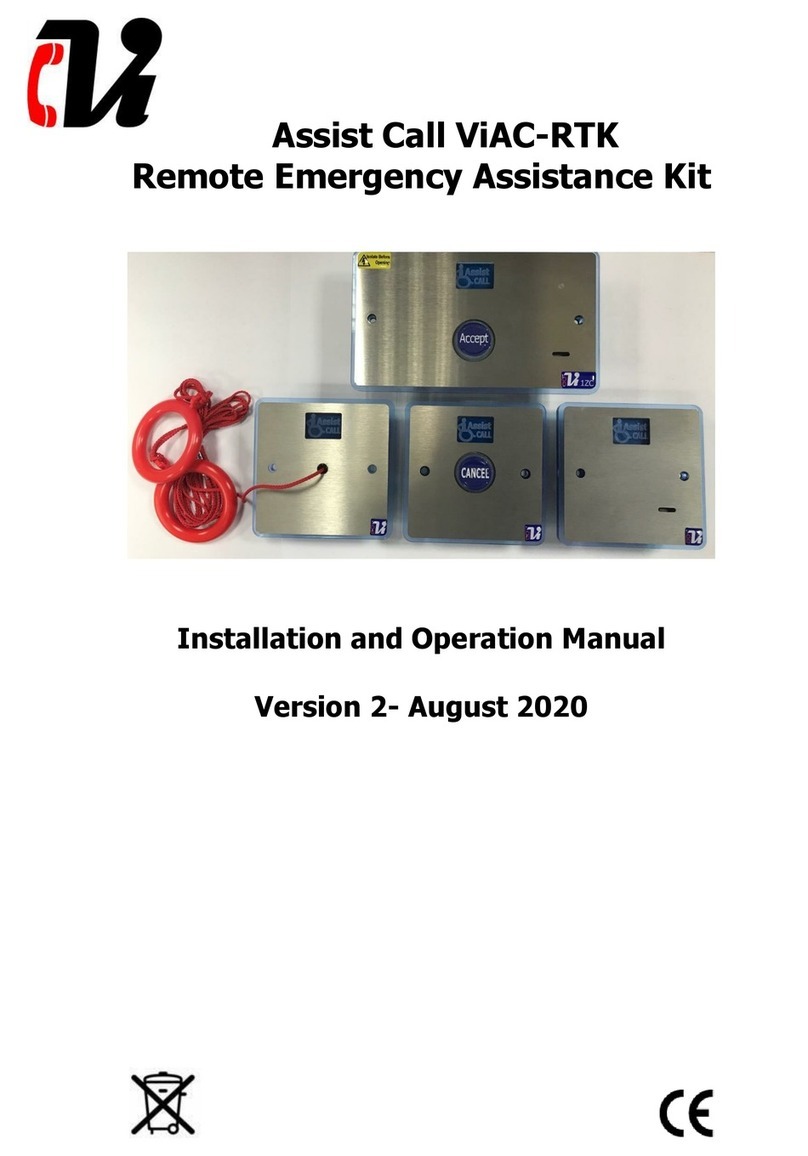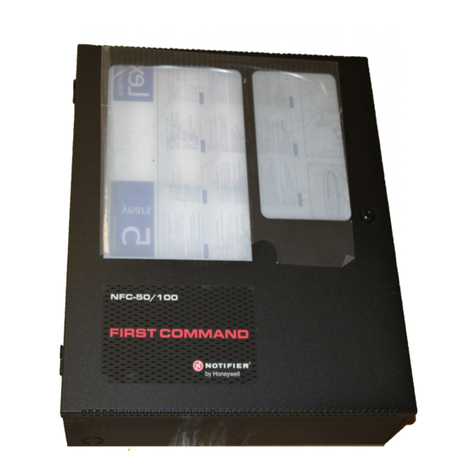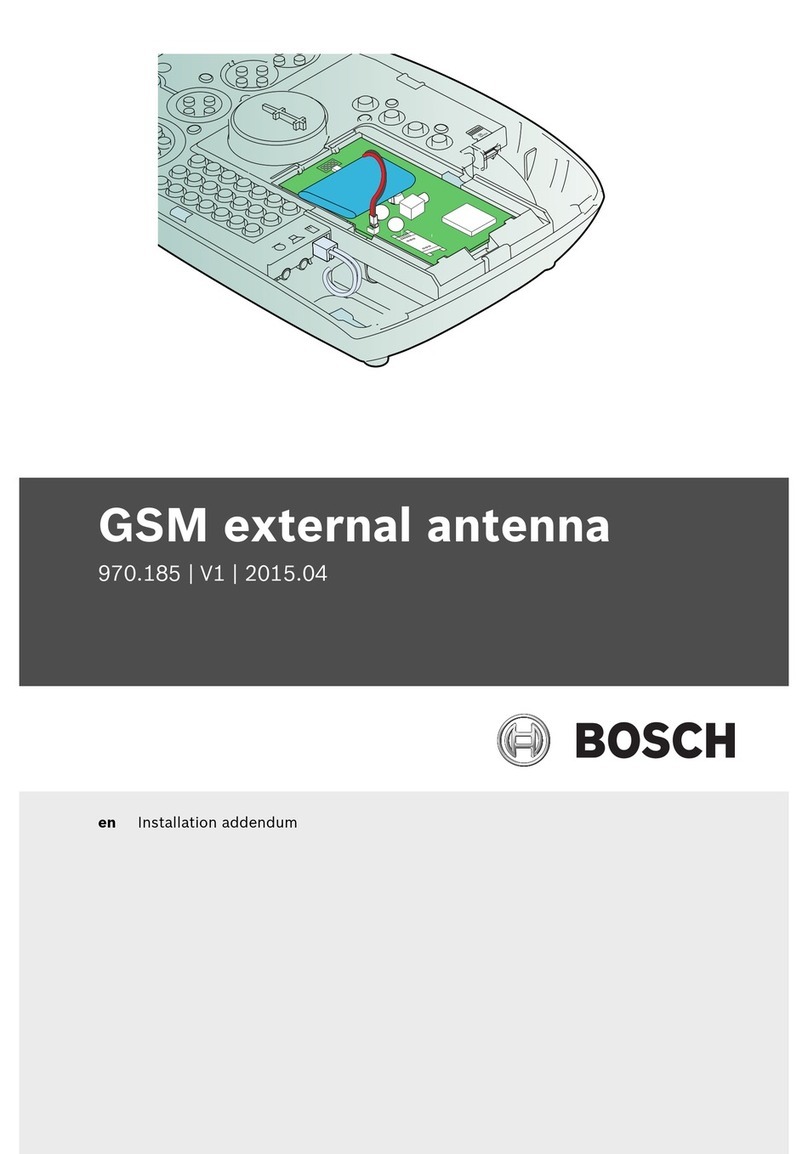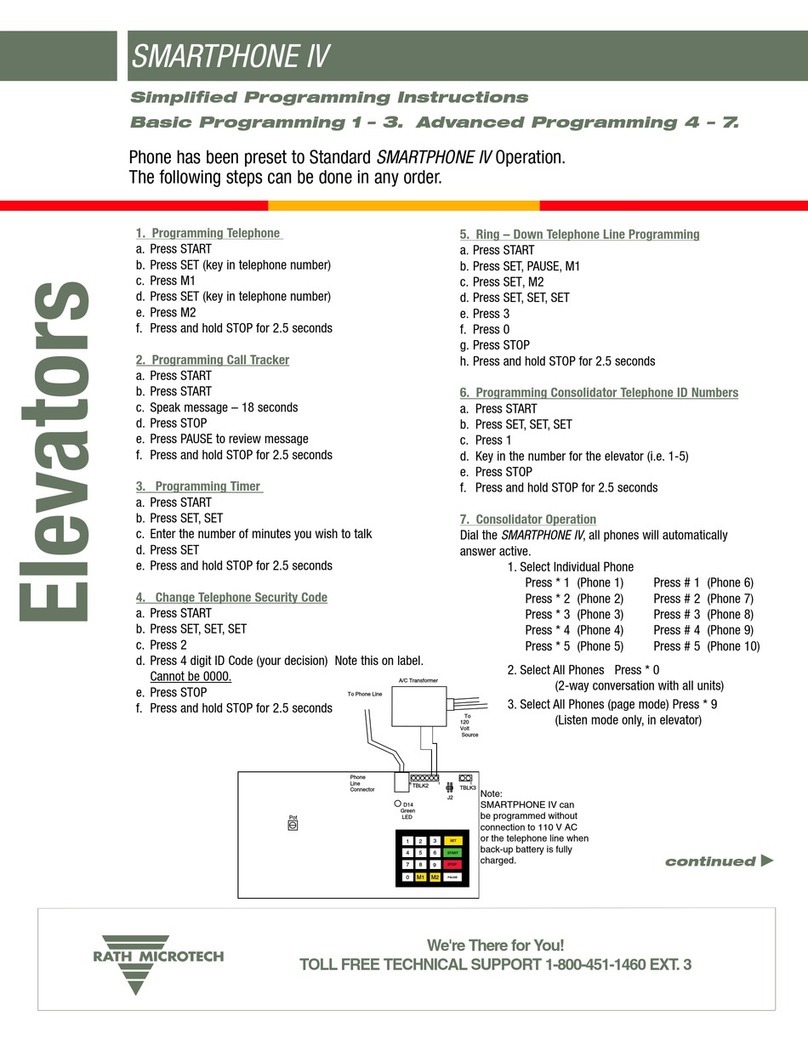Rocom EC II GSM SE User manual

EC II GSM SE
User Manual

User Manual – EC II GSM SE 2
1 Table of contents
1
TABLE OF CONTENTS ....................................................................................................2
2
NOTES AND DISCLAIMER ..............................................................................................5
3
CO YRIGHT......................................................................................................................5
3.1
Description of goods.......................................... Fehler! Textmarke nicht definiert.
3.2
Warranty....................................................................................................................
3.3
Updates .....................................................................................................................
3.4
Repair return procedure ............................................................................................
3.4.1
Service form .................................................. Fehler! Textmarke nicht definiert.
4
GENERAL..........................................................................................................................6
4.1
Contents of packing...................................................................................................6
4.1.1
Accessories...........................................................................................................7
4.2
Technical data ...........................................................................................................7
4.2.1
Physical dimensions and functions.......................................................................7
4.3
Connections on central unit.......................................................................................8
5
INTRODUCTION ...............................................................................................................9
.1
Foreword ...................................................................................................................9
.2
Product description....................................................................................................9
5.2.1
Overview of F ltCom GSM SE functionality .........................................................9
6
INSTALLATION...............................................................................................................12
6.1
Installation of central unit ........................................................................................12
6.1.1
Installation of SIM card .......................................................................................14
6.1.2
Connection of battery..........................................................................................14
6.1.3
GSM antenna ......................................................................................................14
6.1.4
Connection of speech unit ..................................................................................14
6.1.5
Alarm button........................................................................................................14
6.1.6
Emergency light ..................................................................................................15
6.1.7
Intercom ..............................................................................................................15
6.1.8
Output 12V DC....................................................................................................15
6.1.9
Relay output ........................................................................................................16
6.1.10
Filter input .......................................................................................................16
6.1.11
Loop amplifier .................................................................................................16
6.2
Installation of speech unit........................................................................................16
6.2.1
Adjustable sound ................................................................................................17
6.2.2
Frame mounting ..................................................................................................17
6.2.3
Recessed mounting ............................................................................................17
6.2.4
Mounting behind Car Operating Panel (COP) ....................................................17
6.2.5
Mounting of ALBU version ..................................................................................18
6.2.6
Alarm Button connector ......................................................................................18
6.2.7
External LED connector ......................................................................................18
6.2.8
Connector for Central Unit ..................................................................................18
7
EMERGENCY OWER SU LY....................................................................................18
7.1
Battery .....................................................................................................................18
7.2
Battery charging ......................................................................................................19
7.3
Battery test ..............................................................................................................19

User Manual – EC II GSM SE 3
7.4
Battery alarm and reset alarm.................................................................................20
8
ROGRAMMING.............................................................................................................21
8.1
Check list before start up and programming ...........................................................22
8.2
Setup of programming mode...................................................................................22
8.3
Standard functions which must be programmed.....................................................22
8.3.1
Programming of PIN code...................................................................................22
8.3.2
Reset to factory setting .......................................................................................23
8.3.3
Closing or breaking alarm button........................................................................23
8.3.4
Alarm telephone number and alarm code...........................................................23
8.3.5
Test alarm to test the installation ........................................................................24
8.4
Optional functions that may be programmed ..........................................................24
8.4.1
Automatic test alarm ...........................................................................................24
8.4.2
Change delay time for alarm button....................................................................25
8.4.3
Answer function ..................................................................................................25
8.4.4
Active and passive alarm mode..........................................................................25
8.4.5
Battery alarm receiver.........................................................................................26
8.4.6
Simple phone acknowledgement........................................................................26
8.4.7
Disconnection of acknowledgement ...................................................................27
8.4.8
Change of PIN code on SIM card .......................................................................27
8.4.9
Unlock the SIM card............................................................................................27
8.4.10
Filter input .......................................................................................................27
8.4.11
Programmable alarm type ..............................................................................28
8.4.12
Change of security code.................................................................................28
8.4.13
Change of alarm flashing sequence...............................................................28
8.4.14
Stop sending battery alarm.............................................................................29
8.4.15
Relay control...................................................................................................29
8.4.16
End-of-alarm ...................................................................................................29
8.4.17
Magnetic switch ..............................................................................................30
8.4.18
Disabling of “alive” flash in speech unit ..........................................................30
8.4.19
Change of communication protocol................................................................31
9
SMS FUNCTIONALITY ...................................................................................................32
9.1
Basic instructions to send an SMS..........................................................................32
9.2
Retrieving the telephone number ............................................................................32
9.3
Checking the signal strength ...................................................................................32
9.4
Checking and/or programming................................................................................33
9.
Checking the status of battery and test alarm.........................................................3
9.6
Resetting an active battery alarm............................................................................36
9.7
Checking the alarm log............................................................................................36
9.8
Sending an SMS when an alarm is trigged.............................................................37
9.9
Remote reset of the lift phone .................................................................................40
10
ALARM RECE TION ......................................................................................................41
10.1
Alarms sent to a automatic alarm central................................................................41
10.2
Alarms sent to a telephone .....................................................................................42
10.2.1
Acknowledging an alarm ................................................................................42
10.2.2
Speech exchange...........................................................................................43
10.2.3
Termination of active alarm mode ..................................................................43
10.2.4
Forwarding a call ............................................................................................43
11
CALLING THE FÄLTCOM GSM SE ...............................................................................43
12
U DATING THE SOFTWARE ........................................................................................43

User Manual – EC II GSM SE 4
13
LED INDICATIONS .........................................................................................................44
13.1
The three LED´s of the central unit .........................................................................44
13.1.1
LED A – Green LED indicates mains voltage.................................................44
13.1.2
LED B – Green LED indicates function of GSM-module:...............................44
13.1.3
LED C – Three colored LED (red/green/yellow):............................................44
13.2
LED´s (red/green/yellow) on the speech unit..........................................................4
14
FUSES IN CENTRAL UNIT.............................................................................................45
15
TROUBLESHOOTING ....................................................................................................46
1 .1
It is not possible to enter programming mode.........................................................46
1 .2
FältCom GSM SE does not make an alarm call .....................................................46
1 .3
FältCom GSM SE calls up automatically at power on ............................................46
1 .4
Whistling sound from loudspeaker at alarm sequence ...........................................46
1 .
Disturbances during voice communications............................................................46
15.5.1
Battery alarm ..................................................................................................46
1 .6
Technical support ....................................................................................................46
16
ROGRAMMING OVERVIEW ........................................................................................47
17
CONTACT INFORMATION.............................................................................................50

User Manual – EC II GSM SE
2 Notes and disclaimer
We would like to thank you for placing your confidence in Rocom Energie- und Kommunika-
tionssysteme GmbH and are convinced about the choice of one of our security products fulfils
your expectations. In order to operate this EC II GSM SE correctly we would ask you to read
this manual carefully.
The contents of this document may be changed without prior notice due to the continuous
development of methods, design and manufacturing. Rocom Energie- und Kommunika-
tionssysteme GmbH disclaims any responsibility for damage caused by possible errors in this
document.
Some of the functionality described in this document is not available in earlier product re-
leases. Contact your local distributor or Rocom GmbH for more information. Please visit our
website www.rocom-gmbh.com where the latest product documentations are found.
3 Copyright
This document belongs to Rocom Energie- und Kommunikationssysteme GmbH, and may
only be reproduced, adapted or transcribed after written permission from copyright proprietor.
Copyright © 2011
3.1 Warranty
There is a 2-year warranty (24 months) for manufacturing failure or material failure commenc-
ing with the delivery date.
Warranty does not include:
- Incorrect or careless usage
- Damages caused by thunderstorms or air pollution.
- Vandalism or damage.
- Normal wear
- Emergency power supply battery
Rocom Energie- und Kommuikationssysteme GmbH reserves the right to determine if the
product will be repaired or replaced. Warranty ceases to be valid if defects occur due to incor-
rect use, or other method of application, or context that has been specified in this manual.
3.2 Updates
Visit our website to get access to the latest updates for market information and technical
documentation. Following information can be found:
- Product surveys
- Market material
- Updated user manual
- Software and available updates
- Installation and maintenance instructions
- Contact information
www.rocom-gmbh.com
3.3 Repair return procedure
Rocom Energie- und Kommunikationssysteme GmbH only accepts returns, which are ac-
companied by a completed ticket, which can be on our webside on the support page. If the

User Manual – EC II GSM SE 6
product is purchased from one of our distributors the buyer must first contact the distributors
for assistance. Please note that the battery cannot be enclosed at return of goods.
All returns must be sent well packed with freight paid to the address:
Service department
Rocom Energie- und Kommunikationssysteme GmbH
Lessingstr. 20
63110 Rodgau, Germany
Repaired products are sent to customers as a regular post parcel with freight paid on the as-
sumption that the product is included by warranty. If the investigation shows that there are no
defects on the returned product the customer is charged with a service fee and freight charge.
The customer can ask for a quotation for repair of product not covered by warranty.
4 General
4.1 ontents of packing
Packing for EC II GSM SE contains following parts:
Central unit, includes:
- Central unit
- Programming Guide
- Mounting screws
- Cable tie
- Modular cable, 3 meter
- GSM-antenna
Battery,
- Battery 12V 2Ah
The type of speech unit to be delivered is decided when you place the order. Below is a list of
some of the available types but there are also other speech units. Please contact your local
distributor or Rocom GmbH for more information.
Speech Unit EC II SE, includes:
- Speech unit
- Mounting frame
- Mounting screws
- Label
Speech Unit Behind CO SE, includes:
- Speech unit behind COP
- Mounting screws
- Label
Speech Unit EC II SE ALBU, includes:
- Speech unit with integrated double breaking alarm button
- Mounting frame
- Mounting screws
- Label

User Manual – EC II GSM SE 7
4.1.1 Accessories
Following parts can be ordered separately from Rocom GmbH or from our distributors:
- Surface mounting alarm button with double-breaking function.
- External alarm button with internal microphone (ALBU), 8m cable
- Emergency light 12V W
- Battery 12V 2Ah
- Telephone handset for intercom
- Loop Amplifier
4.2 Technical data
4.2.1 hysical dimensions and functions
Data Speech Unit: E II SE E II OP SE E II ALBU
-----------------------------------------------------------------------------------------------------------------------
Size: 12 x12 x23 mm 10 x90x26 mm 180x12 x2 mm
Weight: 280 g 21 g 32 g
Material: 1. mm stainless steel 0.7 mm AluZink 1. mm stainless steel
Data: entral unit Speech units
-----------------------------------------------------------------------------------------------------------------------
Size: 18 x200x7 mm See above
Weight, excl. battery: 1780 g See above
Operating temperature: + °C to +40°C + °C to +40°C
Air humidity: 30 % to 90 % 30 % to 90 %
Casing material: 1.2 mm AluZink See above
Emergency power: Battery 12V 2Ah Powered by Central unit
Power supply: 230V / 0.1A / 0-60Hz Powered by Central unit
Indications: Three LED. One is two-colored Yellow and green LED and sound
Pictogram on front plate
Installation: On top of lift car Inside lift car (behind COP or
with frame)
Alarm button inputs: Three inputs of which two One input
with microphone (ALBU)
LED outputs: - 12VDC, max 20mA
Antenna: External 0 Ω -
GSM: Dual band 900/1800 MHz -
Programming: By keypad or remote
programming via SMS
Protocol: CPC and P100
Signaling: DTMF
Speech switchover: Duplex or simplex
Test alarm: Interval between 1-9 days
Battery alarm: Automatically
Alarm receiving: Contact your local distributor for information of alarm centers that ac-
cepts the CPC or P100 protocol. Any phone with tone selection (with
buttons * and #) is suitable as alarm receiver.
Connection Cable: A three meter standard Ethernet cable with 8 wires is included in the
deliverance for connecting the speech unit and the central unit

User Manual – EC II GSM SE 8
4.3 onnections on central unit
Central unit connections below marked
Function: onnection: Data:
1. Power supply: 2-pol. screw terminal block 230V AC 0-60 Hz
2. Speech unit: RJ-4
3. Antenna connection: FME/f
4. Emergency light: 2-pol. screw terminal block Max 12V W
. Alarm button 1: 2-pol. screw terminal block
6. Alarm button 2 (ALBU): -polig SPOX 2. 0 mm Adapted for Part No. 2122
7. Alarm button 3 (ALBU): -polig SPOX 2. 0 mm Adapted for Part No. 2122
8. Intercom: 2-pol. screw terminal block For standard telephone according to TBR21
9. Filter connection: 2-pol. screw terminal block Optional active high/low
10. 12VDC output: 2-pol. screw terminal block Nominal load 100 mA/Max 00 mA
11. Relay output: 2-pol. screw terminal block Max 0V 1A
12. Loop amplifier: 2-pol. screw terminal block Signal between 0-100 mV/1 kΩ impedance
12
6
7
2
9
8
5
3
10
4
11
1

User Manual – EC II GSM SE 9
5 Introduction
5.1 Foreword
We recommend a carefully reading of this user manual before EC II GSM SE is put into op-
eration, to ensure that the product is used safely and effectively.
EC II GSM SE should only be used in the context for which it is intended. All other form of
usage will be considered as being solely the users own risk. Only qualified persons are per-
mitted to install, program and start-up this product. Start-up is only allowed after the product
has been properly installed. As a consequence Rocom GmbHdisclaims all responsibility for
possible defects, operational disturbance, accidents etc. caused by lack of knowledge or
carelessness from the user. The same principle is valid for all not approved changes to the
product.
EC II GSM SE uses a GSM standard for mobile telephony. The product can consequently not
be used in areas without satisfactory coverage. Since the GSM system is using radio based
technology, disturbances may occur when using other telephone- or radio sets which are not
sufficiently protected against radio waves. The product is following valid security standards for
exposure of electromagnetic radiation.
Rocom GmbH reserves the right to make changes in the product for functional or commercial
reasons. The company is not forced to immediately update reference manuals.
E II GSM SE cannot be used:
• On places where there are an explosion hazard.
• On places where chemical substances are used in a greater extent with particu-
lar regard to safety rules for environments filled with unstable gases or fumes.
5.2 Product description
EC II GSM SE is an alarm equipment for the GSM network with built in duplex speech com-
munication designed for installation in lifts. It complies with requirements according to
EN81:1–2 and EN81:28. The product is CE-marked.
The system consists of two separate units, one central unit which is mounted on top of the
roof of the lift and one speech unit that is mounted inside the lift car and the two units are
joined together with a modular cable.
When someone inside the lift pushes the alarm button, the EC II GSM SE automatically calls
an alarm centre or a predefined alarm receiver and indicates where the alarm comes from. At
the same time voice communications is established and the person in distress can speak di-
rectly to staff at the alarm centre from where help will be dispatched.
EC II GSM SE is normally programmed via a keypad on the rear side of the speech unit but
can also be remote programmed via SMS.
5.2.1 Overview of EC II GSM SE functionality
The central unit of the EC II GSM SE is not visible to the passengers of the lift. It is mounted
on the roof of the lift car. Its function is to initiate, transmit and monitor alarm calls from the
speech unit in the lift to the alarm centre through the GSM network. The central unit contains
a printed circuit board with a GSM module and an emergency power supply with a lead acid

User Manual – EC II GSM SE 10
battery. Most of the external connections such as antenna, alarm button/s, mains powers etc.
are made to the central unit.
The speech unit of the EC II GSM SE is available in several different versions where some of
them can be mounted visible for the lift passenger. The user then only sees the lift phone as a
discreetly designed panel with perforated screen plate for the loudspeaker and microphone.
On the lift phone front plate there is a laser engraved pictogram and two LED that indicates
the alarm and the GSM network status. The space-saving design of the speech unit facilitates
mounting within the lift car. Loudspeaker, microphone and keypad for programming are inte-
grated in one single unit. This means quick and easy installation as well as high reliability in
operation.
The speech unit can be mounted on the wall, behind the wall or on ceiling of the lift car, which
eliminates the need to make holes other than those needed for the modular cable. Intercon-
nection of the central unit and speech unit is very quick and simple since a standard modular
cable is used.
5.2.1.1 Alarm calls
EC II GSM SE is activated with a standard alarm button in the lift or, if required, with a sepa-
rate alarm button. There is also a version of the speech unit which has an integrated alarm
button. It is possible to install up to two separate alarm buttons with built-in microphones.
These alarm buttons are intended for mounting on top of or below the lift car to be reached by
a trapped technician. When someone presses the alarm button for more than seconds, the
alarm calling process is activated in the EC II GSM SE. Time delay is programmable between
1 and 30 seconds. EC II GSM SE can call up to six different alarm receivers or ordinary tone
dialing telephones. Two alarm numbers can be programmed to use a special alarm code to
Speech unit
Central unit
GSM
network
Lift car Alarm centre
Alarm button

User Manual – EC II GSM SE 11
identify EC II GSM SE in an alarm centre. It is also possible to have an SMS sent together or
instead of the speech connecting alarm.
5.2.1.2 rogramming
The rear side of the speech unit has a keypad for programming call numbers, function selec-
tion and testing. There are also connectors for the central unit, an alarm button and two ex-
ternal illuminated pictograms. All settings are made during the installation and, normally, no
subsequent changes are required. It is however also possible to program the EC II GSM SE
remotely via SMS.
5.2.1.3 Incoming calls
To contact possible trapped persons there is the possibility to phone in to the EC II GSM SE.
Normally it is open for incoming calls but the function can be shut down or programmed so
that it only allows incoming calls only after a lift alarm has occurred.
5.2.1.4 ower supply
The built-in emergency power supply monitors and tests the battery regularly. If the battery
becomes bad and needs to be replaced, a battery alarm is sent to an alarm receiver. It is also
possible to manually reset a battery alarm with a button on the printed circuit board on the
central unit. The product cannot be used without a mounted and connected battery.
5.2.1.5 Emergency light
It is possible to connect the lift’s emergency light to EC II GSM SE, which automatically turns
the light on when the mains power is cut off. When the mains return the emergency light is
switched off. In the central unit there is a 12V DC output, which can be used for external
equipments such as an alarm bell or a loop amplifier for hearing impaired people. The output
is connected to voltage even after power failure, on the condition that the emergency power
supply has not been disconnected from the battery to protect it against deep discharging. To-
gether with the relay output on central unit, these two outputs can be used for, example, to
activate an external alarm bell. The relay actuates every time any of the alarm buttons are
activated but can also be activated remotely.
5.2.1.6 Intercom
There is a possibility to connect an intercom telephone to the central unit for communications
between the lift car and, for example, the machine room of the lift. Most telephones can be
used, but they must be approved for connection to the public telephone network (TBR21 ap-
proved). The intercom starts when telephone receiver is lifted and finishes when the tele-
phone receiver is hung up. If a lift alarm should occur while intercom is in progress the lift
alarm has priority and will disconnect the intercom.
5.2.1.7 Automatic test alarm
EC II GSM SE can be set to send an automatic test alarm to a dedicated test alarm receiver
with an interval of 1–9 days. The alarm is send soundlessly and tests the electronics and re-
ception quality of the EC II GSM SE If the test alarm should not occur, an alarm will be acti-
vated at the alarm centre and personnel can be sent to the lift to investigate and take care of
possible defects.
5.2.1.8 Filtering
To reduce the number of false alarms it is possible to connect EC II GSM SE with the control
equipment of the lift to the filter input. Then it is possible to filter out all alarms attempts from
the lift if the function is normal to reduce the workload on the alarm centre. For security rea-
sons no external alarm buttons (ALBU´s) are included by the filtering.

User Manual – EC II GSM SE 12
5.2.1.9 Loop amplifier
There is the possibility to connect a loop amplifier to the central unit which makes it easier for
people with impaired hearing to hear what is said in the speech unit. Check with your local
distributor or Rocom GmbH for information about approved loop amplifier units to connect to
EC II GSM SE.
5.2.1.10 Technical alarms
In some cases a technical alarm needs to be sent from the lift to the alarm receiver to indicate
a fault in the installation. One of the two available alarm button inputs can be used for that
purpose. If the alarm button input in the speech unit is connected to the alarm button in the lift
the free input in the central unit can be used for technical alarms.
The inputs are default set to breaking function which means that an alarm is generated when
opening up the circuit. The alarm type for the alarm is default set to 10d but must be change
with a programming sequence, see section 8.4.11 below. The technical alarm output from the
lift must be able to generate an open or close signal. Note that the alarm receiver must be
able to receive the alarm type that is used for technical alarms.
6 Installation
Only competent and qualified personnel may install the EC II GSM SE. Knowledge, technical
skill and correct equipment are required for safe and efficient installation.
Warning!
Mind your own safety when installing EC II GSM SE. You must never work in an open lift shaft with-
out a safety harness. Be extremely careful and break current if you work close to a voltage of 230-
400V, e.g. in the lift engine room. Never disconnect a cable before you have made sure that it is not
connected to any voltage. After installation the low tension cables (SELV) have to be bundled to-
gether so they cannot come near live wire or parts of the mains voltage if a connection loosens from
terminal block.
6.1 Installation of central unit
The Central unit is most easily mounted on the roof of the lift either in a lying or standing posi-
tion. Ensure that is possible to connect, both to the electric system and the alarm button from
the site of erection in the lift car. The central unit should not be mounted on top a lighting fit-
ting that can raise ambient temperature and therefore shorten the lifetime of the battery. The
enclosed mounting screws or other suitable screws should be used.
Standing installation Lying installation

User Manual – EC II GSM SE 13
It is very important that the EC II GSM SE has the best possible GSM-signal to prevent com-
munication disturbances. Find the best possible position before mounting of the central unit.
Place a standard mobile phone in the imagined site of erection, make a speech connecting
call and run the lift slowly through the whole lift shaft. If there is a disturbance or interruption
of the call – choose another position and do the whole procedure again. Make sure that the
same operator is used which is intended to be used by the EC II GSM SE.
It is also possible to mount the central unit in the machinery room if no good GSM signal is
available on the lift car roof. Then the modular cable between the speech unit and the central
unit must be replaced by an 8 wire lift cable, preferable with twisted pairs. Cut the modular
cable in the middle and connect all wires using a screw connector to the lift cable to be used.
Connections in central unit
Power supply
230V AC
Battery connection
SIM Card holder
Relay output
Max 0V 1A
Emergency light
Max 12V W
Output 12V DC
GSM antenna connection
Alarm button
Filter input
Extra alarm
button 1 and 2
Intercom Loop amplifier
Modular cable
(from speech unit)

User Manual – EC II GSM SE 14
6.1.1 Installation of SIM card
Mains voltage must not be connected during this stage! The SIM card is mounted in the
holder in the upper right corner of the printed circuit board. Make sure that the contact sur-
faces are facing downwards and that the holder is closed properly after mounting. Please
note that the address book in the SIM card must be empty because the address book is used
as a memory during programming and existing numbers can destroy normal functionality.
1. Pull lock back and fold up 2. Place SIM card turned right side up 3. Fold down and pull lock forward
6.1.2 Connection of battery
The enclosed battery is mounted in the intended position in the enclosure of the central unit
and battery terminals are connected to corresponding battery cable. For polarity – see picture
in the section Installation of central unit.
Only batteries approved by Rocom GmbH of type sealed lead acid-batteries may be con-
nected to the EC II GSM SE. Other batteries could lead to danger for the user and/or damage
EC II GSM SE. Damages caused by incorrect battery types are not covered by warranty.
6.1.3 GSM antenna
The enclosed antenna is mounted in intended position in the chassis antenna contact on the
external enclosure of the central unit. If there is a problem with sufficient GSM reception, im-
provement of the situation can possibly be achieved with another type of antenna. Contact
your local distributor or Rocom GmbH for more information.
6.1.4 Connection of speech unit
One end of the enclosed modular cable is connected to socket in the central unit and the
other end is connected to the speech unit.
6.1.5 Alarm button
The alarm button in the lift car can be connected to the alarm button input on the speech unit
or on the central unit. Both alarm inputs are pre-programmed for breaking alarm buttons and
therefore a jumper is mounted on both connectors. Only remove the jumper on the alarm but-
ton input that will be used. Note that there is a speech unit version with an integrated alarm
button, see section 4.1 above.
Note that the alarm button in the lift car normally is double-breaking, i.e. made for two sepa-
rate connections. One of them is usually connected to a local bell and the other one used for
Be sure not to mix up polarity!

User Manual – EC II GSM SE 1
the EC II GSM SE. The connections must be galvanic isolated. Contact your local distributor
or Rocom GmbH for more information.
Note that the alarm button may have closing or breaking function. Breaking function is pre-
ferred and is the default setting for the EC II GSM. If the alarm button has closing function, the
EC II GSM SE must be programmed to handle this, see section 8.3.3 below.
If the lift does not have a double-breaking alarm button the build-in relay output in central unit
can be used to activate an external alarm signal bell. If the lifts existing alarm bell is not con-
nected to an emergency power supply it is possible to use the 12VDC output that is con-
nected in series with relay output. Note that the current consumption of the alarm bell must
exceed the declared value for the 12VDC output. To avoid misunderstanding only one alarm
button should be mounted in the lift car.
There is also a possibility to mount two extra alarm buttons (ALBU) with built-in microphones
on e.g. roof of the lift or under the lift car accessible, for example, a trapped lift technician.
Contact your local distributor or Rocom GmbH for more information.
6.1.6 Emergency light
It is possible to connect an emergency light to EC II GSM SE which automatically switches on
when the mains power is lost. When mains returns the emergency light switches off.
Output is adapted for an emergency light on maximum 12V W. Use the existing emergency
light or contact your local distributor or Rocom GmbH for more information.
This output is protected with fuse as protection against possible short circuit, see section 14
below.
6.1.7 Intercom
For communications between lift machine room and the lift car there is a possibility to connect
an intercom phone to the central unit. Most types of phones can be used as long as they are
approved for connection to the telephone network (TBR21 approval).
A connection is made automatically when the receiver is lifted and the connection is cleared
when the receiver is replaced. If a speech connected lift alarm is made at the same time as
the intercom is connected, the intercom is connection is broken and the lift alarm calls out as
usual. The Intercom is reconnected when the alarm call is finished if the receiver is still off the
hook.
If an incoming voice call is made at the same time as the intercom is in use, the intercom will
be disconnected and the voice communication starts. The Intercom is reconnected when the
alarm call is over if the receiver is still off the hook.
If the intercom receiver is off the hook at the same time as a speech connecting alarm call is
made, the intercom is not connected until the alarm call is finished. Test alarm and battery
alarm functions as usual even if intercom is in progress. Intercom is not affected if the product
is in alarm mode. When the intercom is active a tone is heard in the speaker of the speech
unit every 10th second and is indicated by light signals both in speech unit and in central unit.
Remote programming cannot be done at the same time as the intercom is in progress.
6.1.8 Output 12V DC
This output always supplies 12V DC, even if the product is operating on battery, as long as
the emergency power supply is not shut off to protect the battery against deep discharging.

User Manual – EC II GSM SE 16
The maximum load on the output is 100 mA (continuously) to not influence the battery opera-
tion time of EC II GSM SE. For shorter periods it can be on load with up to 00 mA e.g. for the
external alarm bell. If the lift does not have a double-breaking alarm button this output to-
gether with the build-in relay output on central unit can be used to activate an external alarm
bell, which can be connected in series with relay output and 12V DC output.
The output is protected with fuse against possible short circuit and overload, see section 14
below.
6.1.9 Relay output
There is a potential free connection on the central unit with relay function. Default the relay is
activated if any of the alarm buttons is pressed down and will remain activated as long as the
alarm button is activated. The relay can also be programmed to be activated remotely, see
section 8.4.1 below.
The relay is not affected by the alarm button delay or if filter function is activated. The relay
output is of the type normally open (NO) and may be on load with maximum 0V 1A.
This output can be used to control external devices such as door locks or to activate an alarm
bell if the lift existing alarm button not is of double-breaking type. See section 6.1.8 above.
6.1.10 Filter input
To reduce the number of false alarms, it is possible to connect the EC II GSM SE to the con-
trol equipment of the lift via the built-in filter input. By letting the lift decide if lift alarm should
dial out; the number of false alarms can be reduced. For this function the control equipment of
the lift must be able to generate a signal that the EC II GSM SE can use. Possible additional-
connected alarm buttons (ALBU) are not affected by this filtering.
As a security reason it is possible to bypass an active filter if the alarm button is pressed for
more than 30 seconds.
The function is activated with a special programming sequence, see section 8 below.
6.1.11 Loop amplifier
To enable passengers with impaired hearing to communicate with alarm centre there is a
possibility to connect a loop amplifier. Contact your local distributor or Rocom GmbH for in-
formation about approved loop amplifier to be used with EC II GSM SE.
The loop amplifier output on EC II GSM SE has a signal level of 0-100 mV and an internal
impedance of 1 kΩ. Suitable load impedance is 10 kΩ. The output can be short circuited with-
out causing any damage.
The loop amplifier must work during power failure. Connect it to a power supply that is work-
ing during power failures. It can be connected to the EC II GSM SE’s own 12V output only if it
fulfils the requirements which are described under the section 6.1.8 above.
6.2 Installation of speech unit
Select a suitable place for the speech unit. Avoid installing it in a corner or behind anything
that may reflect the sound. This might lead to acoustic feedback instability between the loud-
speaker and the microphone.

User Manual – EC II GSM SE 17
6.2.1 Adjustable sound
It is possible to adjust the sound level in the speech unit with a trim pot. The trim pot is hidden
behind the small plastic protection part covering and protecting the key pad tail. Remove
carefully the plastic part and use a small screw driver to increase or decrease the sound. The
sound is increased by turning the trim pot counter clockwise and the sound is decreased by
turning it clockwise. Normally the factory setting is enough for most types of lift cars.
6.2.2 Frame mounting
Mark and pre-bore the holes for the speech unit frame at suitable position according to en-
closed drill template. Drill the holes for the modular cable to reach modular contact on speech
unit. The modular cable cannot be led between the keyboard and the lift wall because the dis-
tance between the keyboard and the wall is too small when the speech unit is screwed into
the frame. This requires the hole for the modular cable to be drilled next to those of the edges
of the frame, see the enclosed drill template.
Mounting of speech unit in the enclosed frame
6.2.3 Recessed mounting
There is also a possibility to mount the speech unit without frame, so called recessed mount-
ing. Drill a hole in the centre of the selected place and then make a hole with a 86 mm rotary
hole saw or drill. See the enclosed drill template. Mark the holes for the mounting screws and
pre-bore.
6.2.4 Mounting behind Car Operating anel (CO )
There is a special version of the speech unit which is specially designed for mounting behind
a button and display plate. This alternative is only possible if there is already a prepared
space for a lift phone behind the button & display plate. Since the design of the display may
vary, we are not able to give exact mounting instructions here. Keep in mind that the micro-
phone hole must be aligned with a hole in the display plate. It might become necessary to drill
a new hole. For the best sound quality, the distance between the speech unit front plate and
the display plate should not exceed 1 mm.
Make sure that you do not saw or drill in existing cabling when you make holes!

User Manual – EC II GSM SE 18
6.2.5 Mounting of ALBU version
Mounting of the speech unit version with integrated alarm button is done in the same way as
described in section 6.2.2 above. The only difference is that no external alarm button must be
connected, since this is already pre-wired from delivery. The alarm button is double breaking
and the second circuit can for instance be used to activate an external alarm button in the lift.
6.2.6 Alarm Button connector
The alarm button in the lift car can be connected to the connector marked ALARM on the
speech unit (see picture below) or to the central unit. In case it is connected to the speech
unit - remove the jumper and connect the alarm button. The alarm button input is default set
to breaking and if that is not the case this must be changed. See section 8.3.3 below for in-
formation about how to change this.
Connectors on Speech Unit
6.2.7 External LED connector
In case there are external pictograms available in the lift car they can be connected to the
LED connectors on the speech unit marked “G LED” (green) and “Y LED” (yellow), see pic-
ture above. Make sure the polarity is not mixed up. See section 4.2.1 above for information
about the technical data of the LED connectors.
6.2.8 Connector for Central Unit
One end of the enclosed modular cable is connected to socket in the central unit and the
other end is connected to the speech unit input marked “COM”. See picture above.
7 Emergency power supply
EC II GSM SE has an integrated emergency power supply that ensures the product works by
mains failures by connecting the built-in battery. It also allows connection of emergency light
and operation of possible external equipment such as external alarm bell or similar.
The central unit is intended for fixed installation to input mains. The central unit must be con-
nected to 230V AC and be fused with maximum 10A to the input mains. An easily accessible
mains switch must be available for the input mains to the central unit. Both the input conduc-
tors must be fixed together and anchored with a cable tie 10 mm from the terminal and be
well separated from the printed circuit board low voltage parts.
7.1 Battery
Only sealed lead-acid batteries approved by Rocom GmbH may be connected to EC II GSM
SE. Other batteries may cause danger to the user and/or damage the EC II GSM SE. Dam-
ages caused by incorrect battery types are not included by warranty. Battery lifetime is nor-
mally 2-3 years and should be replaced after that. Warm environments will shorten the battery
lifetime.
The battery in EC II GSM SE contains substances harmful to the environment, mainly lead
and sulphuric acid. Therefore scrapped batteries may not be thrown away with ordinary gar-

User Manual – EC II GSM SE 19
bage but must be disposed of in a responsible way. Follow the regulations from the environ-
mentally responsible local authorities which are valid at the time of disposal. As a rule, the
same procedure may be used which are applied for the disposal of car batteries, because the
EC II GSM SE battery is designed in a similar way.
The EC II GSM SE may not be used if the battery is not mounted and connected, but the bat-
tery can be replaced during operation. If battery is replaced during operation the battery alarm
can be activated but the reset button S1 can reset the battery alarm. If the battery is mounted
with reverse polarity the equipment will not be damaged but a battery alarm will be activated.
After battery replacement it is recommended that the reset button S1 on the printed circuit
board of the central unit is used. It will recharge the new battery completely and test it.
The battery can operate the equipment for at least 60 minutes as long as the current con-
sumption for various connected external units does not exceed the specifications.
Reset button S1
7.2 Battery charging
The built-in battery charger checks that the battery is continuously charged and an empty bat-
tery is fully charged in a maximum of 14 hours. The battery charger is temperature compen-
sated and has a limitation of current charging to prevent damages if an empty battery is
mounted.
7.3 Battery test
The capacity of the battery is tested automatically every 30
th
day and the test can last up to 90
minutes depending on the condition of the battery. The better the battery the shorter the test
will be. If the battery voltage by the battery test sinks below a certain level a battery alarm
goes out. The first battery test is made after 17 hours of operation.

User Manual – EC II GSM SE 20
No battery test is made during ongoing power failure. An ongoing battery test is interrupted
immediately if a power failure occurs or if battery voltage sinks down below a certain level.
7.4 Battery alarm and reset alarm
The EC II GSM SE sends out a battery alarm to indicate that the battery is bad. The battery
alarm is completely silent and an active battery alarm is indicated by a light signal on the
speech unit and on the central unit.
A battery alarm will be sent out at any of following occasions:
•
Battery voltage decreases a certain level at a regular battery test
• Battery is mounted with reverse polarity
• A battery cell has been short circuited
• No battery is mounted
If a battery alarm has occurred the EC II GSM SE sends a reset alarm at any of following of
occasions:
• A regular battery test has been done without any problems
• The reset button S1 on the printed circuit board has been activated
• A battery reset command is sent via SMS
If a battery is replaced after the EC II GSM SE has sent a battery alarm, you should reset the
battery alarm by pressing reset button S1. If this is not done, a reset alarm will be sent out at
next regular valid battery test, which can take up to 30 days. Until then the product will send a
new battery alarm each 3
rd
day as a reminder. The battery reset can also be done remotely
with an SMS, see section 9.6 below.
The EC II GSM SE has a protection against deep-discharging, which protects from deep-
discharging damages at mains failure. This means that if the battery voltage sinks below a
certain level during battery operation the battery will be disconnected and EC II GSM SE will
be shut off. The EC II GSM SE will be restarted automatically at the return of the mains.
Normally the 1
st
. alarm receiver is used as battery alarm receiver together with the first alarm
code. However, it is possible to send all battery alarms to a special battery alarm receiver.
See section 8.4. below.
Table of contents
Other Rocom Emergency Phone manuals
